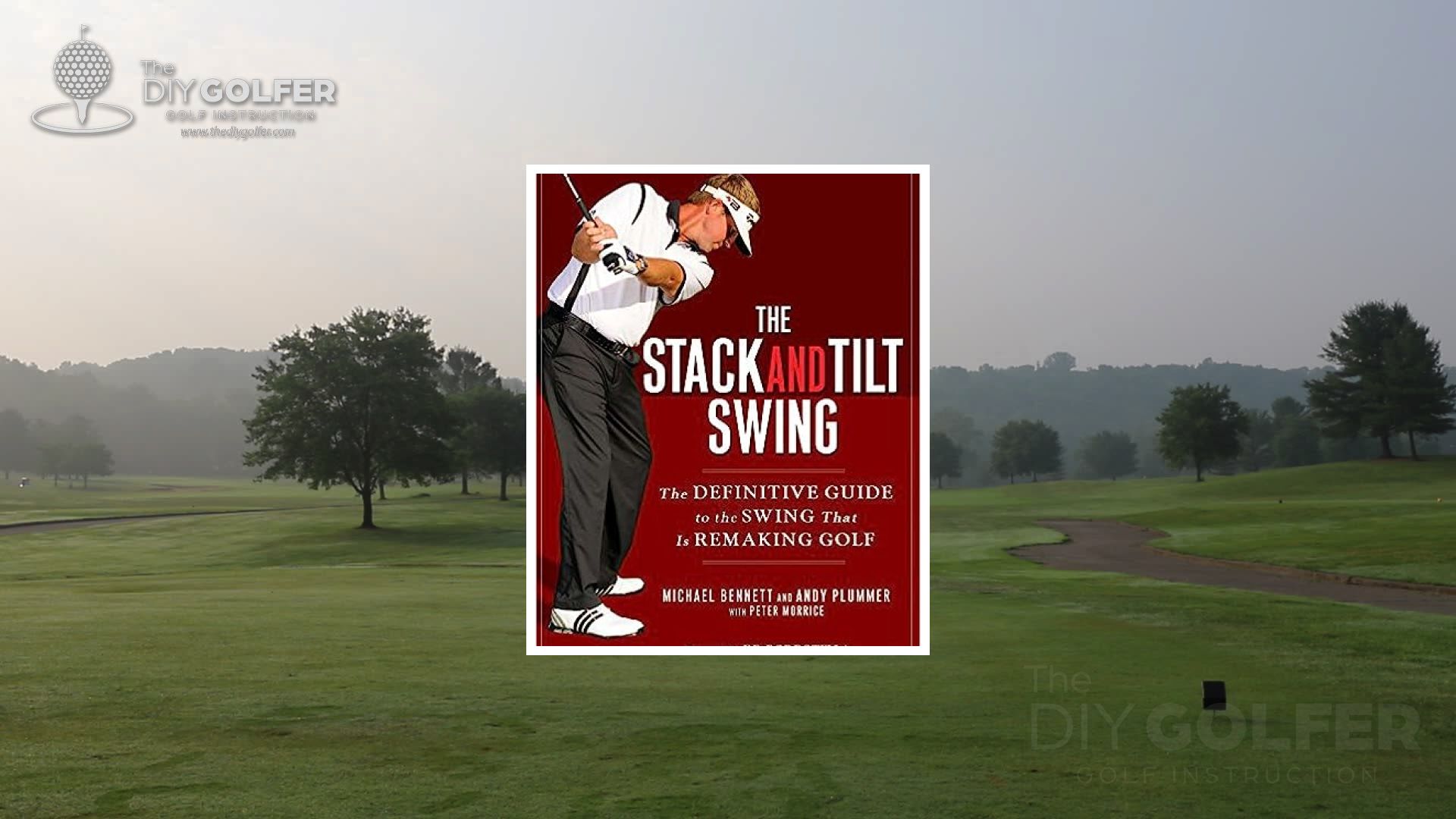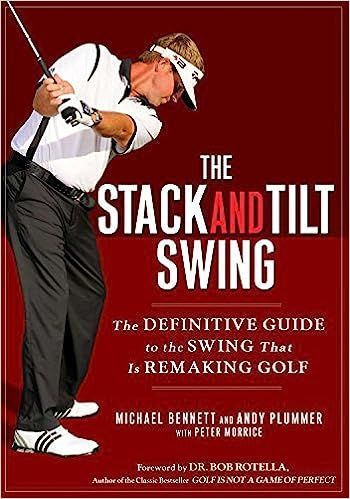Last Updated: Nov 04, 2023
Stack and Tilt Golf Swing: Is it a fad?
There are a lot of criticisms of the Stack and Tilt swing, but certainly not much clarity on the subject. In this post, I break down these misconceptions.

TLDR; What you need to know about Stack and Tilt Book
Here's a quick summary of the most important things you need to know about this product.

Stack and Tilt Book
There are a lot of criticisms of the Stack and Tilt swing, but certainly not much clarity on the subject. In this post, I break down these misconceptions.
Read full reviewOverall Rating
Pros and Cons
Pros:
- Clear swing philosophy
- Highly effective for some golfers
Cons:
- Too unconventional for many players
Best For...
All Golfers
My favorite feature:My favorite part about Stack and Tilt is how it teaches you to swing in to out and hit powerful draws. Golfers can take portions of this philosophy and still benefit!
Table of Contents

Full Review: Stack and Tilt Book

When you were younger, I'm sure you had an encounter with the game called "telephone." You know, that game where one person comes up with a story, tells it to their neighbor, who tells it to their neighbor, etc. etc.? At the end of the game, the first person and the last person compare stories, and 100% of the time, they are drastically different. Interestingly enough, the golf world has been playing a big game of telephone over the past few years, and I want to tell you about it.
The topic is called "Stack and Tilt," and unfortunately, from the first release of the swing concept in 2009 via the published book, the golfing world has been playing one big massive game of Telephone with it.
In this post, I want to weed out some of the misconceptions, share with you how Stack and Tilt wasn't as big of a failure as many think, and finally, how it can help YOUR game.
But before we get into the nitty gritty details, we need to first get a better idea of how the system came about, and who created it.
Meet Andy and Mike
Andy Plummer and Michael Bennett are nothing like the Butch Harmons and Sean Foleys of the world. Nevertheless, they have been named Golf Digest top 100 instructors, and have led several PGA Tour players like Aaron Baddeley and Mike Weir to breakthrough victories.
I'm not going to try and convince you how amazing Aaron Baddeley and Mike Weir are, because they certainly aren't competing on the level of Jason Day, Jordan Spieth, Rickie Fowler, and the other superstars we see every Sunday evening marching down the 18th hole in contention for a PGA Tour victory.
But there is something you should know about these two instructors...
They are systematic, and bring some depth to their instruction. Thanks to work with legendary teacher Mac O'Grady, as well as intensive study of the Golfing Machine (oh yeah, that book that Bryson DeChambeau has made famous?), the Stack and Tilt System isn't far from what many of the players on tour are doing today, despite what everybody claims.
So What is Stack and Tilt?
In short, Stack and Tilt is comprised of 3 core fundamentals, followed by 6 swing positions that make up the "basic form" of the model.
3 Fundamentals
The first thing you need to understand about Stack and Tilt are the three fundamentals underlying the entire system.
Unlike most golf instruction that focuses on grip, stance, alignment, and posture, Andy and Mike take a slightly different approach. They claim that the three fundamentals of golf are as follows:
- Hit the ground in the same place every time (relative to your setup)
- Have enough power to play the course
- Match the clubface to swing path to control shot direction and curvature (or in other words, understand ball flight laws)
The "Basic Form"
In addition to these three fundamentals, Andy and Mike lay out 6 primary positions that a golfer must achieve to fit the "basic form" of Stack and Tilt.
- Weight forward (55/45 for irons, 60/40 for driver and woods)
- Left shoulder down as you turn back
- Hands in on backswing (the opposite of what Jim Furyk does on his takeaway)
- Back leg straight at the top of the swing (look at Ben Hogan at the top of his swing)
- Arms straight post impact
- Butt under torso at finish
Completely Lost?
You should be.
I included the fundamentals and basic form of Stack and Tilt to give you a broad overview of the topic. By no means is this a comprehensive explanation of Stack and Tilt (If you are interested in a more comprehensive look at the different positions, I suggest reading the book, or if you're lazy, reading this article).
What I really want to get across is that Andy and Mike have crafted a system in which you can fully conform to, or simply take individual parts that work for you.
In the book, Andy and Mike start out by saying: "There are two ways to use the Stack and Tilt Swing and this book. First, you can learn how and why all the pieces work and start to develop an effective swing from the ground up. That's the first part of the book. Or you can add pieces to your current technique, based on what will make the biggest difference to the flight of the ball. That's the second part of the book. Both approaches will move you toward the same goal: developing a sound, repeatable golf swing."
Despite popular belief, I don't think that these guys were trying to make everyone look exactly like the Stack and Tilt model, Charlie Wi:
Instead, I think they were two guys who had a keen understanding of the basic truths of a golf swing, and put a fancy label on it.
In light of this, I want to take you through some of the biggest misconceptions of the Stack and Tilt Swing.
Stack and Tilt Myths
Myth #1: Stack and Tilt is a Reverse Pivot
I might say that this entirely depends on how you define "reverse pivot." In most golf communities, a reverse pivot is indicated by the straightening of the back leg and leaning forward at the top of the swing.
Sure, this may be how the reverse pivot is defined, but what is WRONG about the reverse pivot?
Well, the problem with the reverse pivot isn't the fact that the golfer is leaning forward at the top of the swing, but rather the effect that it has during the downswing. Most golfers who have a reverse pivot fail to move their weight forward during the downswing, which causes an over the top, arms-only motion when attacking the golf ball.
So by definition, Stack and Tilt is a reverse pivot.
But, in Stack and Tilt, the goal is to continually shift the weight forward during the downswing.
Even though the spine points away from the target during the downswing, this is just a result of proper forward weight shift.
If you don't believe me, give it a try right now:
Stand up, and make a backswing with the weight staying 55% on the front foot. Notice how your spine is tilted towards the target.
Now, in slow-motion, make a downswing, ensuring that your weight is traveling forward.
You will see that in order for your shoulders to stay centered over the ball, and set up for a solid strike, your spine naturally tilts away from the target.
This isn't a bad thing, as long as the spine is tilting away as a result of a forward weight shift, NOT a backward weight shift (where you start with your weight forward, and end with it backward).
Myth #2: Your Weight favors your front foot at the top of the backswing
I know, this is shocking. It was shocking to me when I first realized it.
Although the Stack and Tilt instructors tell you to keep your weight 55/45 throughout the backswing, you are actually transferring weight to your back foot. They tell you this because our mind plays tricks on us.
How do I know this?
Well, the guys responsible for the 5SK system did some testing of foot pressure with a couple different golfers to see how the weight is distributed through the swing.
It just so happens that Grant Waite, the golfer you see in the video below, is an all out Stack and Tilt player. Look at the weight distribution at the top of his backswing:
In the video, you can see that even a fully conformed Stack and Tilt player has 65% of his weight on the back foot at the top of the swing/in transition.
So what causes this?
From my understanding, this weight distribution is a result of the mass of the club being moved toward your back foot during the backswing.
I'm not all that interested in getting technical with this concept, but you should understand that Stack and Tilt is NOT actually teaching you to keep your weight forward 100% of the time, even though it appears and feels that way.
So that argument that "If a baseball pitcher moves his weight from his back foot forward, then why shouldn't a golfer?" is no longer valid
Myth #3: You have to fully convert to Stack and Tilt for it to be effective
Although this is #3 on the list, I'd argue that it is a large reason for criticisms of Stack and Tilt.
The truth is, you don't have to look like Grant Waite or Charlie Wi to benefit from the Stack and Tilt swing philosophy.
Many of the Stack and Tilt teachings are simple imperatives that have worked over the years, all of which can be applied in pieces.
If you don't want to completely straighten your back leg, but want to get your weight more forward at address, then go for it! I have done this with my own swing, and have seen great success accordingly. Of course, my basic setup and motion doesn't look all that different, but by putting 55% of my weight forward at address, I have learned to keep the weight moving forward throughout the swing a lot more effectively than I had in the past.
If something about the Stack and Tilt philosophy doesn't work for you, then don't worry about it! I suggest reading the book, finding the components that DO work, and applying them to your swing. If you want to fully convert, that is fine as well, but be sure to do periodic checks on video to make sure that you are progressing in the right direction.
Myth #4: You can't hit it far with a Stack and Tilt Swing
This entirely depends on the level of the player.
If Jason Day or Rickie Fowler converted to Stack and Tilt, YES, they would probably lose some distance.
But these guys are pros for a reason. They have fairly efficient swings already.
A large group of amateurs don't, which is the reason for bringing this myth to the table.
Although there are certainly exceptions, I will argue that most amateurs would gain distance from a proper application of Stack and Tilt principles, for the sole reason that they would learn to compress the ball better and learn how to sequence the golf swing more efficiently.
Myth #5: You can't hit the driver with Stack and Tilt
Many golfers falsely believe that by using Stack and Tilt principles with the driver, they will come in too steep and put ugly sky marks on their club.
Since the driver stance is wider than any other club, you must position a slightly larger amount of weight on the front foot at address (60/40 rather than 55/45). That is the only change.
What you must understand is that when the weight continually moves forward, there is no chance that the driver can get steep, and still make solid contact with the ball. This is where the "tuck the butt" principle comes into play. As you tuck the butt immediately before impact, you are essentially shallowing out the club. On top of that, the length of the driver helps this process as well.
Myth #6: Stack and Tilt is Bogus
I had to include this because I've read this on a golf forum before.
Read the book, and THEN criticize. Enough said.
Myth #7: Nobody on Tour uses Stack and Tilt Principles
Although some players like Aaron Baddeley, Charlie Wi, Grant Waite, and Mike Weir have distinct Stack and Tilt swings, there are plenty of other tour pros who embody some of the underlying principles of the swing philosophy.
Several of Sean Foley's students such as Justin Rose and Sean O'Hair show signs of Stack and Tilt in their swing.
Sure, they aren't 100% converted, but remember what I said in point #3?
How Stack and Tilt can help your game
Although we covered some of the misconceptions of Stack and Tilt, and briefly covered some of the ways to apply it to your own game, you might be wondering if it is right for you. How do you know?
Here's my answer:
You'll never know until you try.
That doesn't mean you have to go all out and try everything that Stack and Tilt represents. As I mentioned earlier, it could be as simple as setting up with more weight forward at address, and focusing on keeping your shoulders over the ball at all times (I focus on keeping my head still throughout the swing to accomplish this).
If that doesn't work, you might go broader and just focus on moving the weight forward more on the downswing.
Whatever it is that you try, just know that it will take a few range sessions to get comfortable doing it. Also, make sure you are using video analysis to ensure you are hitting the right positions and making forward progress. There is nothing worse than trying to implement something new and getting bad results simply because you implemented it the wrong way.
I hope that by now you have a better understanding of the Stack and Tilt framework. If you are thinking about trying part or all of it out, I highly recommend buying and reading the book. It has tons of pictures and even descriptions of what certain positions feel to various tour pros using Stack and Tilt.






